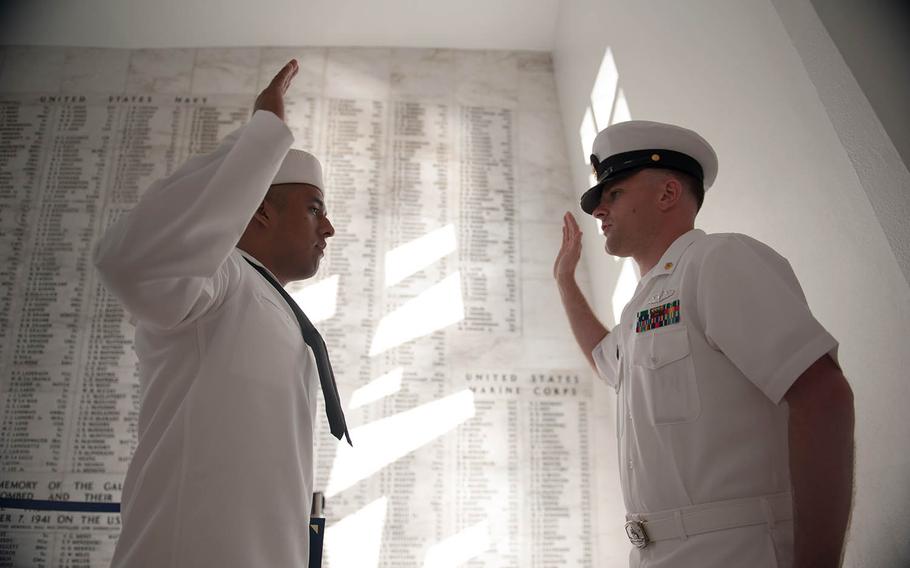
A sailor assigned to the guided-missile cruiser USS Mobile Bay recites the oath of enlistment inside the USS Arizona Memorial at Pearl Harbor, Hawaii, April 24, 2013. (Armando Gonzales/U.S. Navy)
YOKOSUKA NAVAL BASE, Japan – The Navy will require its sailors to reaffirm their oaths to the Constitution during daylong unit stand-downs ordered by the defense secretary to address extremism, including white supremacy.
Chief of Naval Personnel Vice Adm. John Nowell Jr. ordered the renewed oaths Sunday in a message to the fleet detailing the Navy’s plans for the stand-downs that each service must complete before April 2. Both military and civilian personnel are required to participate.
“As public servants, we took an oath to the Constitution and we will not tolerate those who participate in actions that go against the fundamental principles of the oath we share, particularly actions associated with extremist or dissident ideologies,” Nowell said in the message.
Defense Secretary Lloyd Austin on Feb. 3 told each service branch to conduct 24-hour operational pauses to address extremism. His order followed the Jan. 6 insurrection at the Capitol by supporters of former President Donald Trump that included more than two dozen military veterans and at least one current service member, Pentagon spokesman John Kirby told reporters at the time.
In a video message Friday, Austin encouraged service members in all branches to “revisit the oath that you took” when they joined the military.
“Read those words again; consider what they really mean,” he said. “And think about the promise that you made to yourselves and to your teammates and to your fellow citizens.”
The Pentagon does not know how many service members are involved in extremist activity, Kirby said at a press briefing Monday in Washington. Collecting that kind of information is difficult, he said.
The defense secretary, Kirby said, “very much would like to have a better sense of the data. We need to have a better understanding of how broad and deep the problem is.”
Some commands have already held their stand-downs, Kirby said. Others are waiting on training materials being prepared by the Pentagon.
During the Navy’s stand-downs, commands must discuss the oath’s meaning, “including what we protect (Freedom of Speech/Assembly) and the limits on these rights for service members,” according to Nowell’s message. Personnel must also review prohibited activities, including “political activity and social media dos and don’ts.”
Each stand-down must include a listening session, something the Navy has been pushing since last summer. Discussions on racism in the service were encouraged after the civil unrest across the country last year following the death in Minneapolis of George Floyd, an unarmed Black man killed by a white police officer who knelt on his neck.
“Every commander or commanding officer will continue to conduct listening sessions and get it into their battle rhythm,” Nowell said in the message. “This is where the hard work of establishing trust and connectedness starts.”
Kirby on Monday told reporters he did not expect information on numbers of service members involved in extremism to come from those sessions, but “clearly it’s about trying to get a better grasp of the degree to which the problem exists.”
Nowell in his message said the initiative is meant to “ensure service members and civilian personnel clearly understand the damaging effects of extremism and begin developing more effective, sustainable ways to eliminate the corrosive impacts extremist activity can have on our force.”
In a Facebook video posted Saturday, Nowell said Navy personnel may be participating in extremism just by posting, retweeting or liking an offensive post on social media.
“Extremism often breeds hatred and if left unchecked, it can erode the trust in connectedness, something that is so vital to our operational readiness,” he said in the video. “You may not personally know any shipmates with extremist beliefs, but I assure you that those forces of darkness are among us.”
He cited two recent instances of extremism “that highlighted the fact that we still have work to do here.”
Nowell did not elaborate on the incidents, but hate symbols were found this year inside the guided-missile cruiser USS Lake Champlain and aircraft carrier USS Carl Vinson, Reuters reported on Feb. 10.
In the Lake Champlain case, a noose was left on a Black sailor's rack, the report said. The Carl Vinson’s case involved hate speech graffitied on a bathroom wall.
“As sailors, we must strive to be inclusive, creating an environment where every individual understands that they are a valued member of the Navy team,” Nowell said.